Purification of Spherical Graphite as Anode for Li-Ion Battery: A Comparative Study on the Purifying Approaches
Abstract
1. Introduction
2. Experimental Section
2.1. Materials
2.2. Spherical Graphite Purification
2.3. Characterizations
2.4. Electrochemical Investigation
3. Results and Discussion
3.1. Selection of Purification Process
3.2. Characterization of Purified Spherical Graphite
3.3. X-ray Diffraction (XRD)
3.4. Scanning Electron Microscopy (SEM)
3.5. BET Analysis
3.6. Electrochemical Investigation
3.6.1. Cyclic Voltammetry (CV)
3.6.2. Galvanic Charge Discharge (GCD)
4. Conclusions
Author Contributions
Funding
Data Availability Statement
Conflicts of Interest
References
- Wenk, H.-R.; Bulakh, A. Minerals: Their Constitution and Origin; Cambridge University Press: Cambridge, UK, 2016. [Google Scholar]
- Cooper, P.A.; Holloway, P.F. The Shuttle Tile Story. AIAA 1981, 1, 24–34. [Google Scholar]
- Jara, A.D.; Betemariam, A.; Woldetinsae, G.; Kim, J.Y. Purification, application and current market trend of natural graphite: A review. Int. J. Min. Sci. Technol. 2019, 29, 671–689. [Google Scholar] [CrossRef]
- Ovid’Ko, I. Mechanical properties of graphene. Rev. Adv. Mater. Sci. 2013, 34, 1–11. [Google Scholar]
- Zondlo, J.W. Graphite: Structure, properties, and applications. In Graphite, Graphene, and Their Polymer Nanocomposites; CRC Press: Boca Raton, FL, USA, 2012; pp. 1–56. [Google Scholar]
- Billaud, J.; Bouville, F.; Magrini, T.; Villevieille, C.; Studart, A.R. Magnetically aligned graphite electrodes for high-rate performance Li-ion batteries. Nat. Energy 2016, 1, 1–6. [Google Scholar] [CrossRef]
- Edström, K.; Herstedt, M.; Abraham, D.P. A new look at the solid electrolyte interphase on graphite anodes in Li-ion batteries. J. Power Sources 2006, 153, 380–384. [Google Scholar] [CrossRef]
- Washbourne, M. Plenty of sizzle left in Siviour. Aust. Paydirt 2023, 1, 10–11. [Google Scholar]
- Thao, H.M.; Hien, T.T.; Anh, D.D.; Nga, P.T. Mineralogical characteristics of graphite ore from Bao Ha deposit, Lao Cai Province and proposing a wise use. Vietnam J. Earth Sci. 2017, 39, 324–336. [Google Scholar] [CrossRef]
- Jaszczak, J.A. Graphite: Flat, fibrous and spherical. In Mesomolecules: From Molecules to Materials; Springer: Berlin/Heidelberg, Germany, 1995; pp. 161–180. [Google Scholar]
- Yoshio, M.; Wang, H.; Fukuda, K.; Hara, Y.; Adachi, Y. Effect of carbon coating on electrochemical performance of treated natural graphite as lithium-ion battery anode material. J. Electrochem. Soc. 2000, 147, 1245. [Google Scholar] [CrossRef]
- Adham, K.; Bowes, G. Natural graphite purification through chlorination in fluidized bed reactor. In Extraction 2018: Proceedings of the First Global Conference on Extractive Metallurgy; Springer: Berlin/Heidelberg, Germany, 2018; pp. 2505–2512. [Google Scholar]
- Zaghib, K.; Song, X.; Guerfi, A.; Rioux, R.; Kinoshita, K. Purification process of natural graphite as anode for Li-ion batteries: Chemical versus thermal. J. Power Sources 2003, 119, 8–15. [Google Scholar] [CrossRef]
- Chehreh Chelgani, S.; Rudolph, M.; Kratzsch, R.; Sandmann, D.; Gutzmer, J. A review of graphite beneficiation techniques. Miner. Process. Extr. Metall. Rev. 2016, 37, 58–68. [Google Scholar] [CrossRef]
- Jara, A.D.; Kim, J.Y. Chemical purification processes of the natural crystalline flake graphite for Li-ion Battery anodes. Mater. Today Commun. 2020, 25, 101437. [Google Scholar] [CrossRef]
- Safarzadeh, M.S.; Bafghi, M.; Moradkhani, D.; Ilkhchi, M.O. A review on hydrometallurgical extraction and recovery of cadmium from various resources. Miner. Eng. 2007, 20, 211–220. [Google Scholar] [CrossRef]
- Bao, C.; Shi, K.; Xu, P.; Yang, L.; Chen, H.; Dai, Y.; Liu, H. Purification effect of the methods used for the preparation of the ultra-high purity graphite. Diam. Relat. Mater. 2021, 120, 108704. [Google Scholar] [CrossRef]
- Cheng, Q.; Marchetti, B.; Chen, X.; Xu, S.; Zhou, X.D. Separation, purification, regeneration and utilization of graphite recovered from spent lithium-ion batteries-A review. J. Environ. Chem. Eng. 2022, 10, 107312. [Google Scholar] [CrossRef]
- Bolat, E.; Saǧlam, S.; Pişkin, S. Chemical demineralization of a Turkish high ash bituminous coal. Fuel Process. Technol. 1998, 57, 93–99. [Google Scholar] [CrossRef]
- Thi, H.T.; Hong, N.D. Sulfuric Acid Leaching Process for Producing High Purity Graphite from 92.6% C to 98% C. World J. Res. Rev. 2017, 5, 262781. [Google Scholar]
- Wang, H.; Feng, Q.; Liu, K.; Zuo, K.; Tang, X. A novel technique for microcrystalline graphite beneficiation based on alkali-acid leaching process. Sep. Sci. Technol. 2018, 53, 982–989. [Google Scholar] [CrossRef]
- Zhao, S.; Cheng, S.; Xing, B.; Ma, M.; Shi, C.; Cheng, G.; Meng, W.; Zhang, C. High efficiency purification of natural flake graphite by flotation combined with alkali-melting acid leaching: Application in energy storage. J. Mater. Res. Technol. 2022, 21, 4212–4223. [Google Scholar] [CrossRef]
- Bhima Rao, R.; Patnaik, N. Preparation of high pure graphite by alkali digestion method. Scand. J. Metall. 2004, 33, 257–260. [Google Scholar] [CrossRef]
- Wang, H.; Feng, Q.; Tang, X.; Zuo, K.; Liu, K. Insights into alkali-acid leaching of sericite: Dissolution behavior and mechanism. Minerals 2017, 7, 196. [Google Scholar] [CrossRef]
- Crundwell, F. The mechanism of dissolution of minerals in acidic and alkaline solutions: Part II Application of a new theory to silicates, aluminosilicates and quartz. Hydrometallurgy 2014, 149, 265–275. [Google Scholar] [CrossRef]
- Oelkers, E.H.; Schott, J.; Gauthier, J.-M.; Herrero-Roncal, T. An experimental study of the dissolution mechanism and rates of muscovite. Geochim. Cosmochim. Acta 2008, 72, 4948–4961. [Google Scholar] [CrossRef]
- Ma, X.; Yang, J.; Ma, H.; Liu, C.; Zhang, P. Synthesis and characterization of analcime using quartz syenite powder by alkali-hydrothermal treatment. Micropor. Mesopor. Mater. 2015, 201, 134–140. [Google Scholar] [CrossRef]
- Rao, K.S.; Senthilnathan, J.; Liu, Y.-F.; Yoshimura, M. Role of Peroxide Ions in Formation of Graphene Nanosheets by Electrochemical Exfoliation of Graphite. Sci. Rep. 2014, 4, 4237. [Google Scholar] [CrossRef] [PubMed]
- Liu, X.; Wang, W.; Wang, D.; Xiao, B.; Ni, D.; Chen, L.; Ma, Z. Effect of flake graphite size on strength and thermal conductivity of flake graphite/Al composites. Acta Metall. Sin. 2017, 53, 869–878. [Google Scholar]
- Li, W.; Liu, Y.; Wu, G. Preparation of graphite flakes/Al with preferred orientation and high thermal conductivity by squeeze casting. Carbon 2015, 95, 545–551. [Google Scholar] [CrossRef]
- Zhao, L.; Jing, D.; Shi, Y.; Zhuang, Q.; Cui, Y.; Ju, Z.; Cui, Y. TriMethylene sulfite as a novel additive for SEI film formation in lithium-ion batteries. Ionics 2020, 26, 4813–4824. [Google Scholar] [CrossRef]
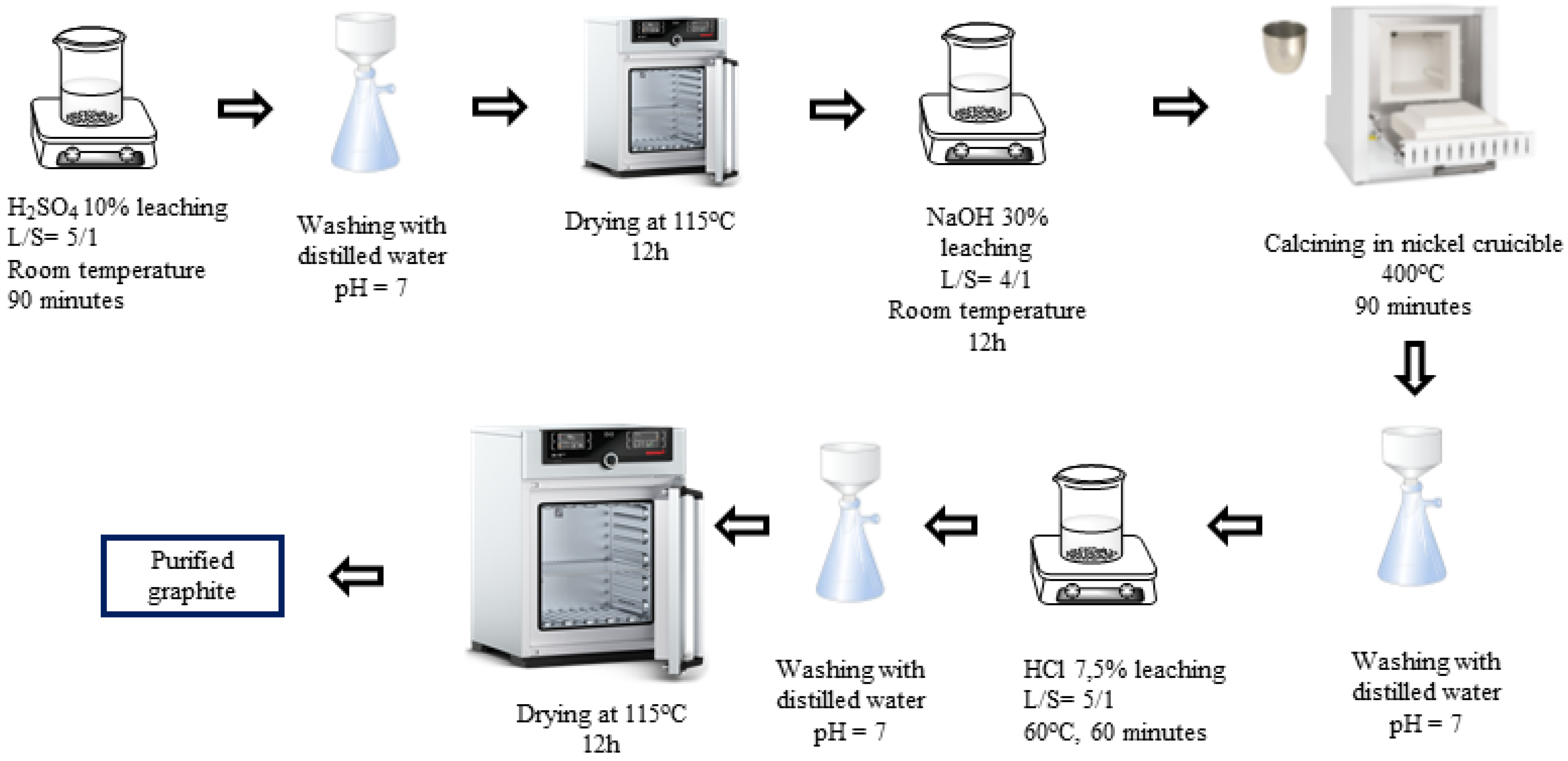
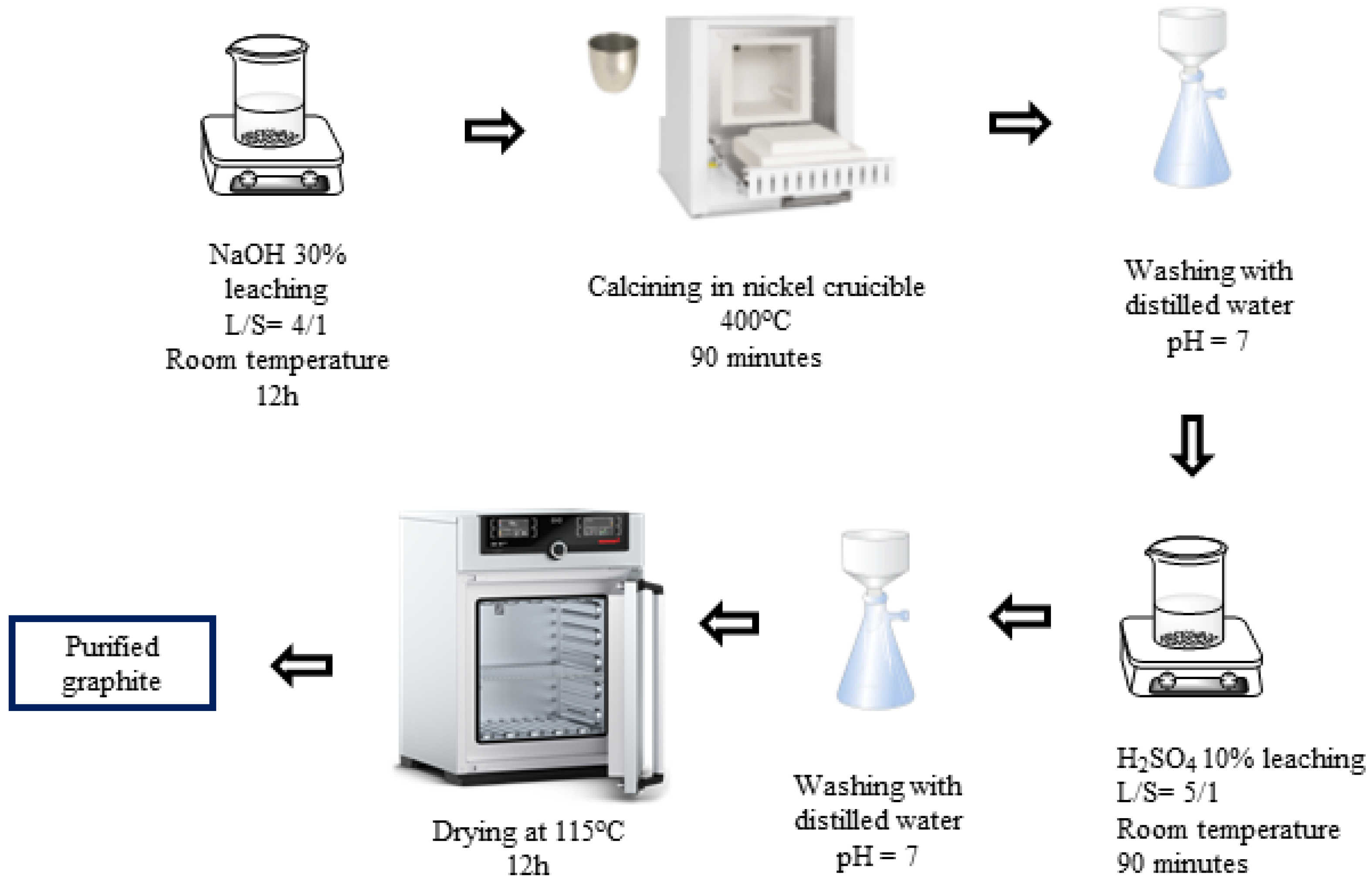
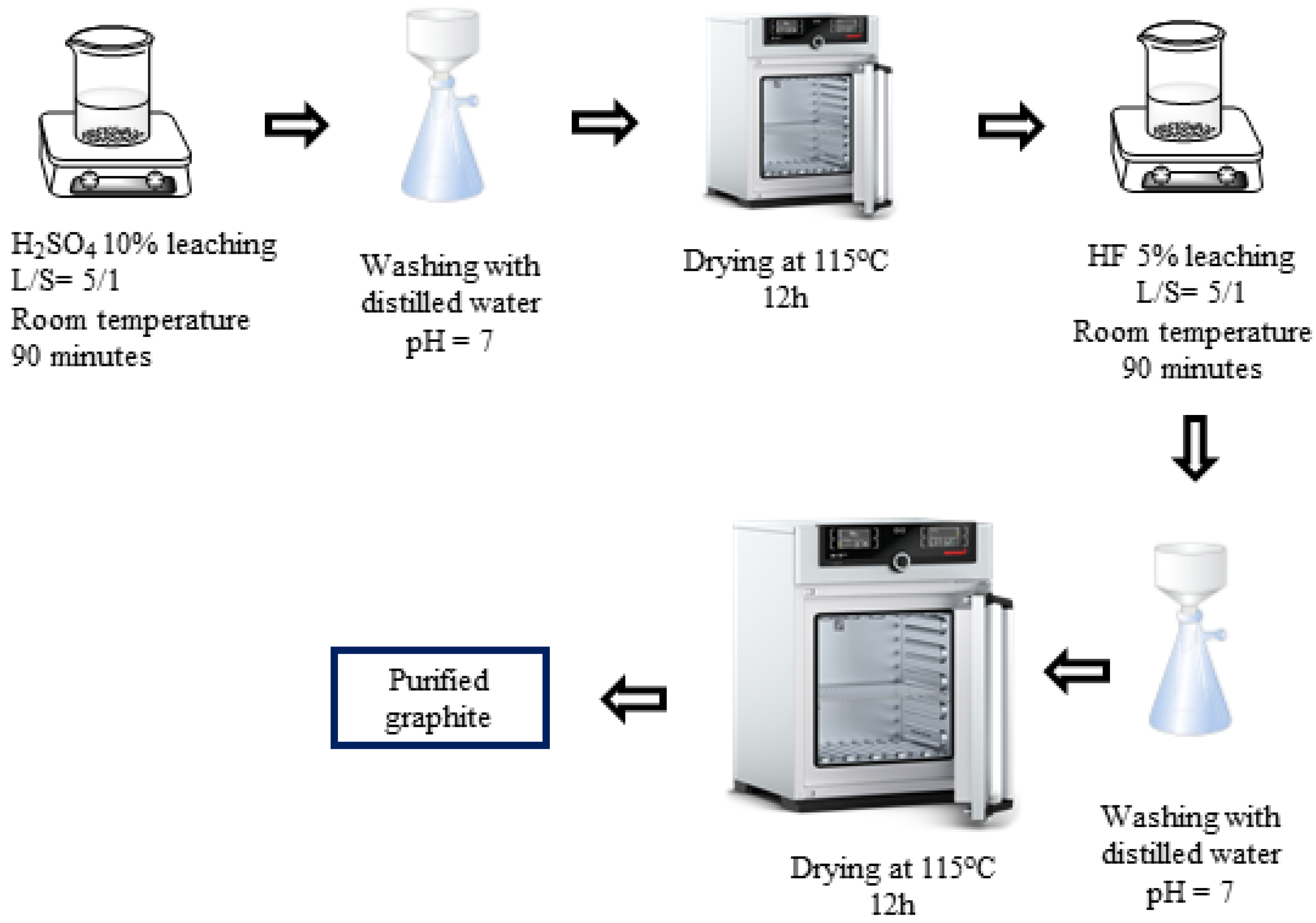
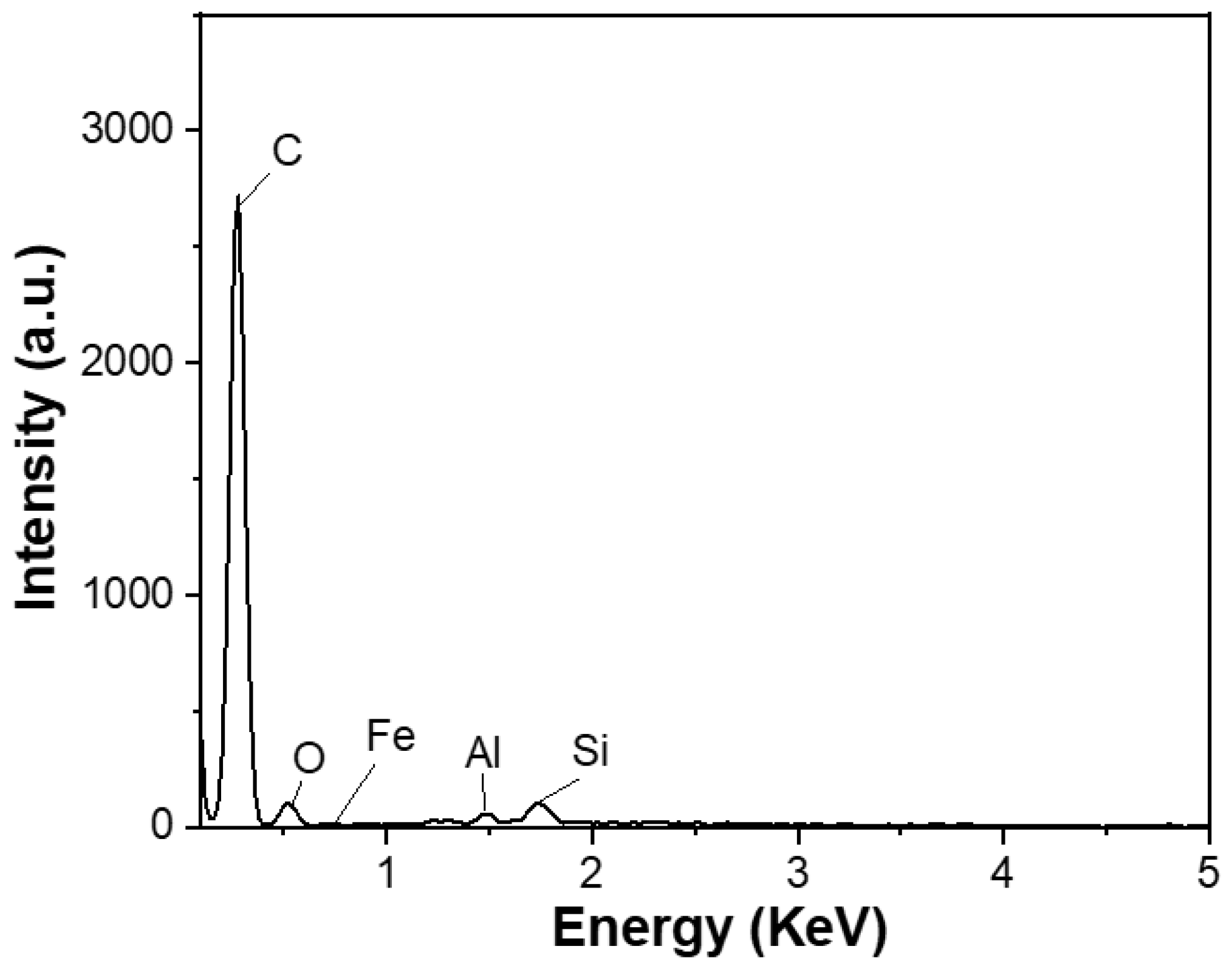
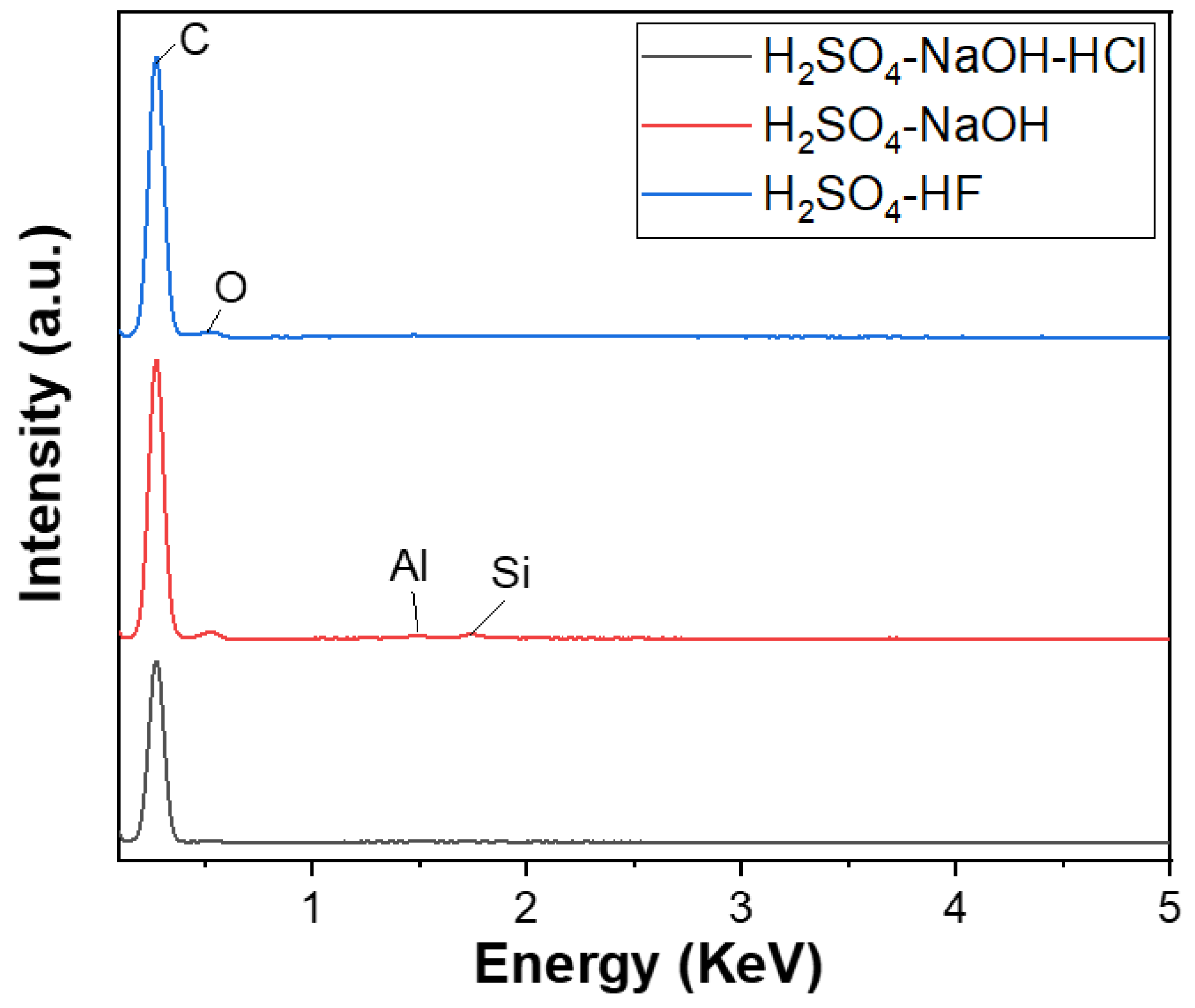
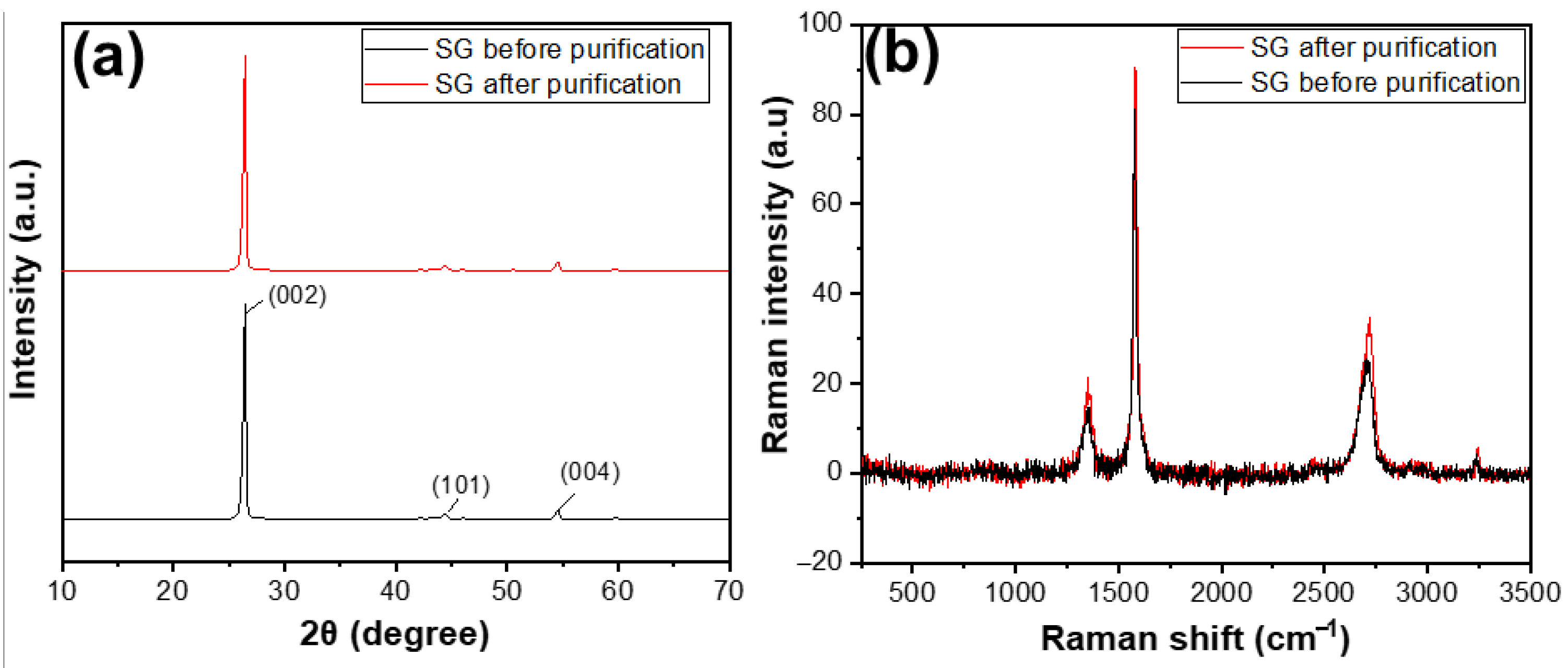
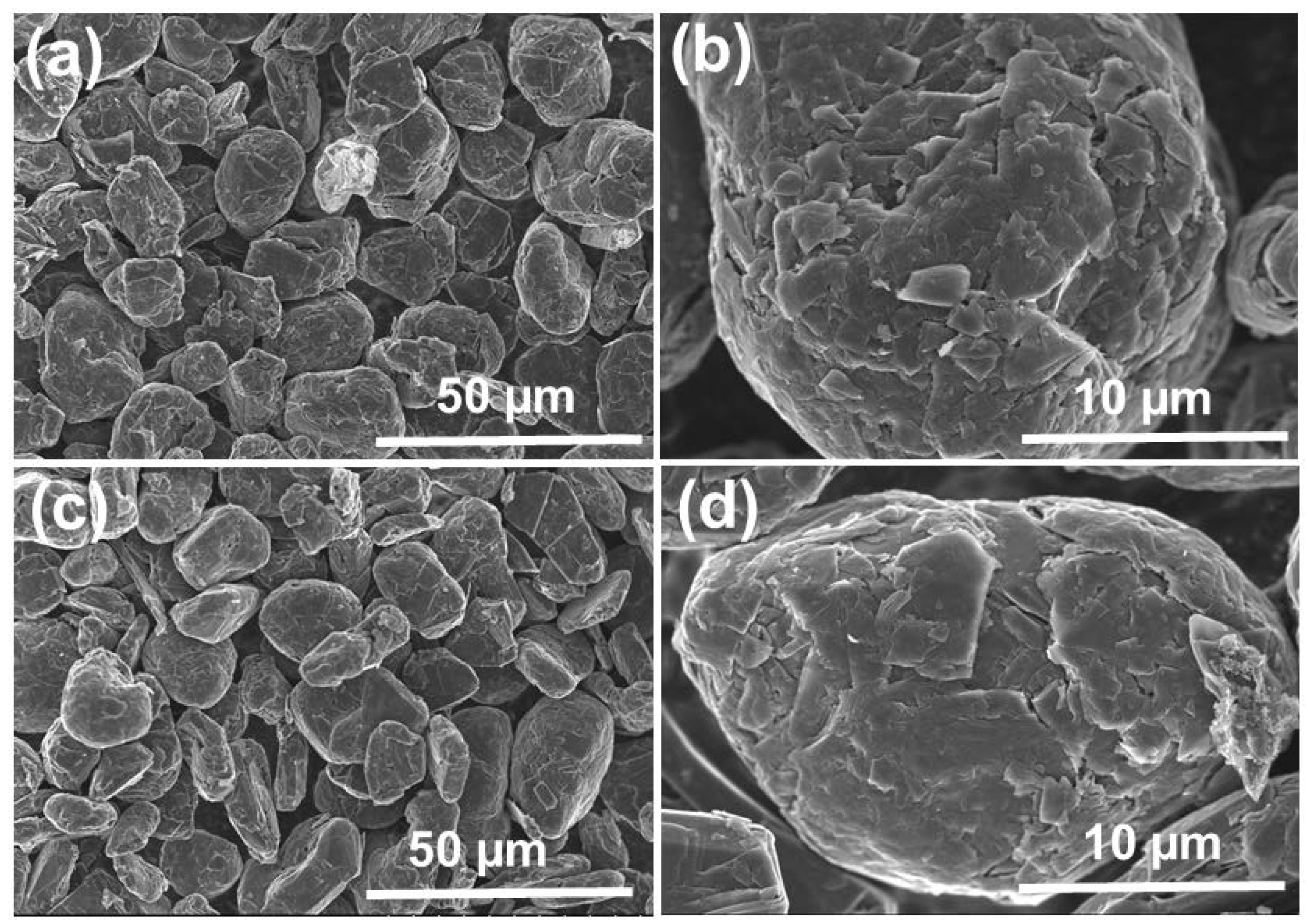
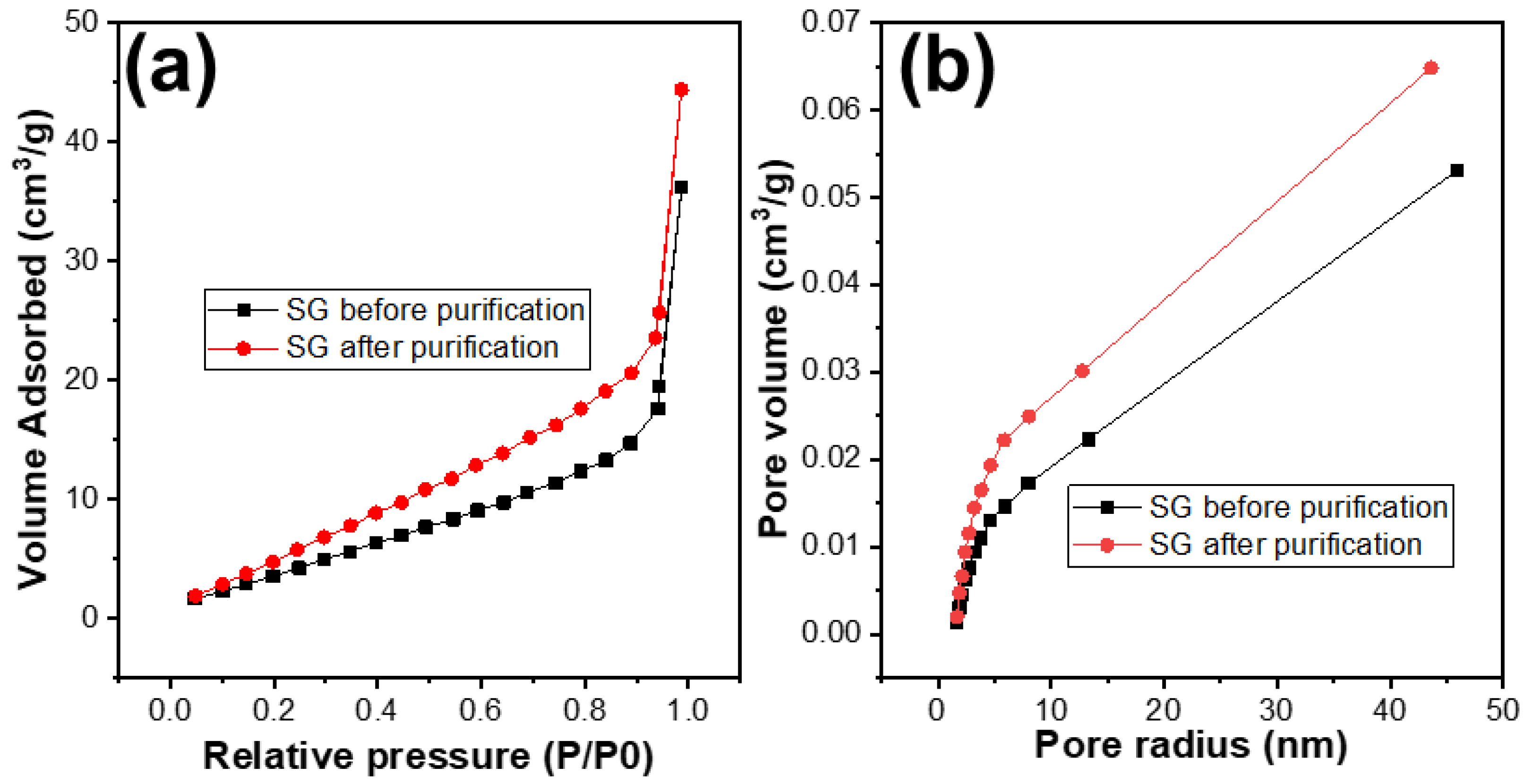
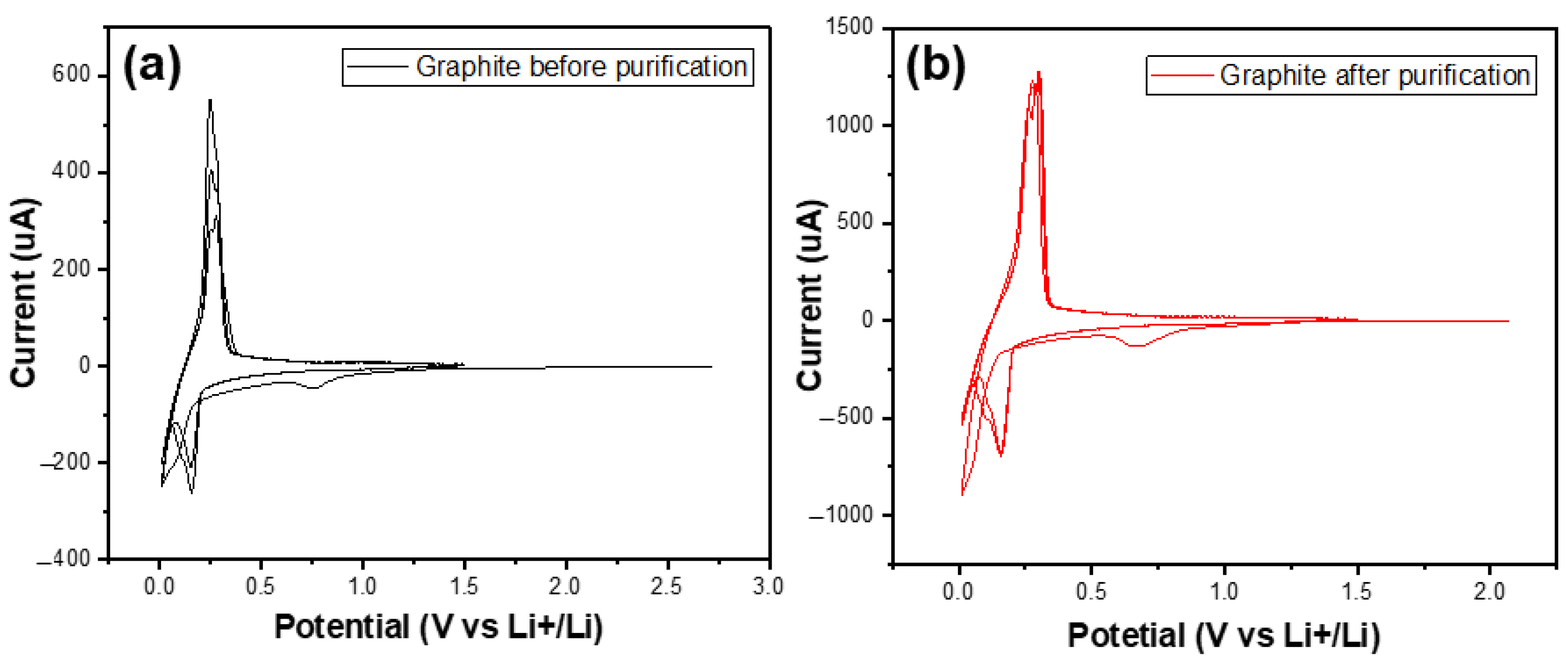
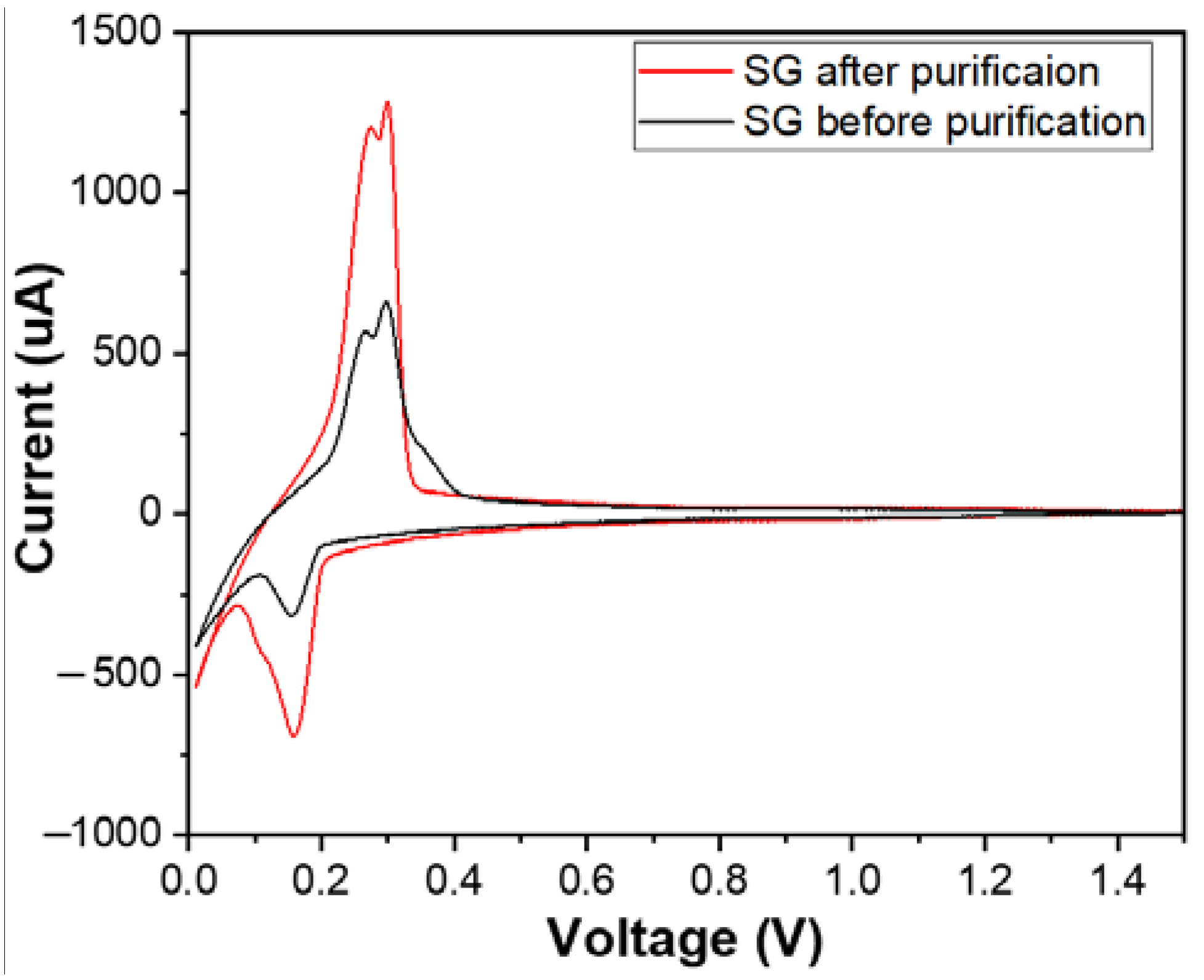

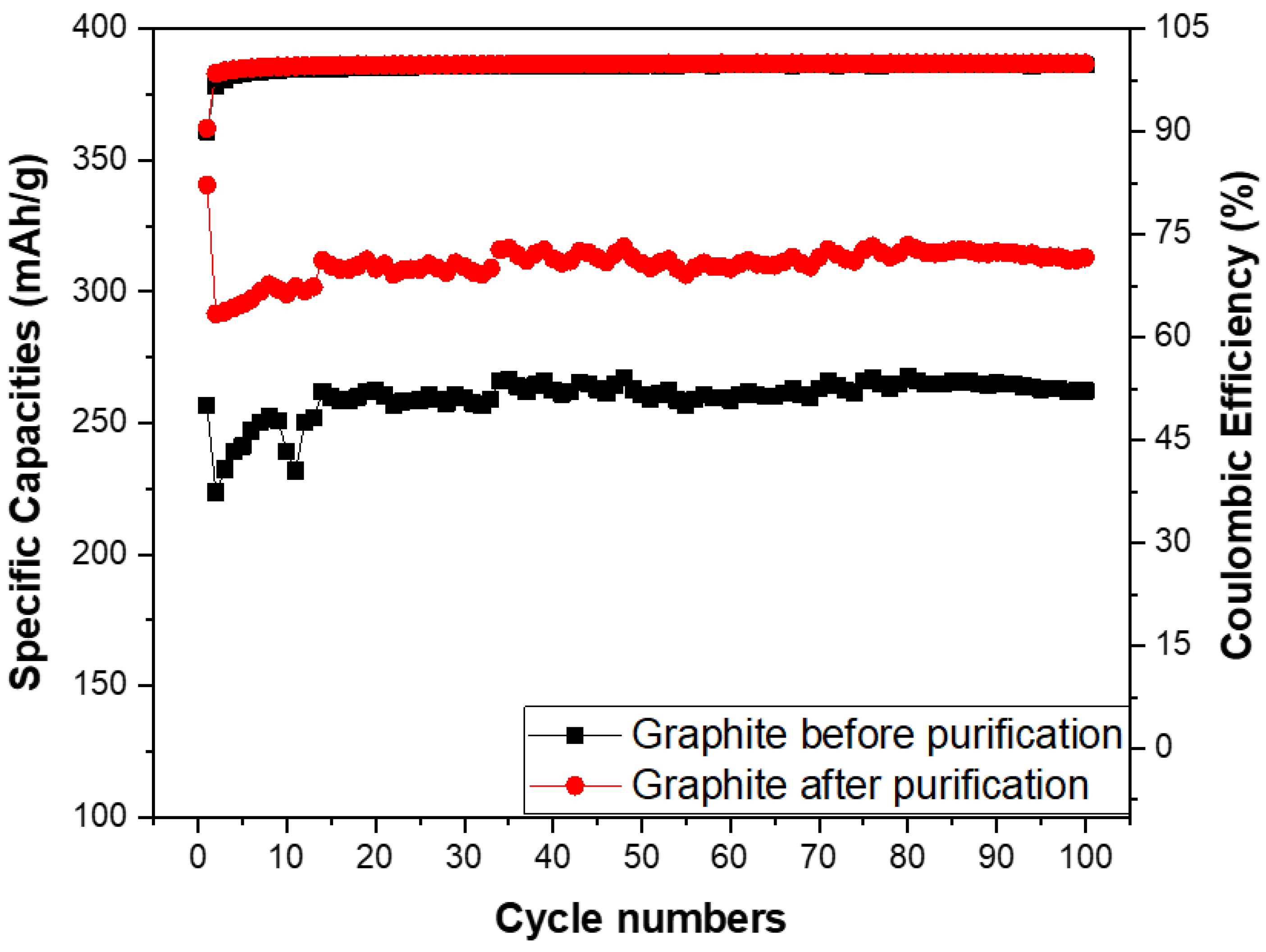
| Parameters | SG1 | SG2 |
|---|---|---|
| Surface area (m2/g) | 20.148 | 30.531 |
| Pore distribution (nm) | 1.888 | 1.889 |
| Pore volume (cm3/g) | 0.053 | 0.065 |
Disclaimer/Publisher’s Note: The statements, opinions and data contained in all publications are solely those of the individual author(s) and contributor(s) and not of MDPI and/or the editor(s). MDPI and/or the editor(s) disclaim responsibility for any injury to people or property resulting from any ideas, methods, instructions or products referred to in the content. |
© 2024 by the authors. Licensee MDPI, Basel, Switzerland. This article is an open access article distributed under the terms and conditions of the Creative Commons Attribution (CC BY) license (https://creativecommons.org/licenses/by/4.0/).
Share and Cite
Vu, T.T.; La, D.D.; Le, L.V.; Pham, T.K.; Nguyen, M.A.; Nguyen, T.H.; Dang, T.D.; Um, M.-J.; Chung, W.; Nguyen, D.D. Purification of Spherical Graphite as Anode for Li-Ion Battery: A Comparative Study on the Purifying Approaches. Micromachines 2024, 15, 827. https://doi.org/10.3390/mi15070827
Vu TT, La DD, Le LV, Pham TK, Nguyen MA, Nguyen TH, Dang TD, Um M-J, Chung W, Nguyen DD. Purification of Spherical Graphite as Anode for Li-Ion Battery: A Comparative Study on the Purifying Approaches. Micromachines. 2024; 15(7):827. https://doi.org/10.3390/mi15070827
Chicago/Turabian StyleVu, Tri Thien, Duong Duc La, Long Vu Le, Trung Kien Pham, Minh Anh Nguyen, Tran Hung Nguyen, Trung Dung Dang, Myoung-Jin Um, Woojin Chung, and Dinh Duc Nguyen. 2024. "Purification of Spherical Graphite as Anode for Li-Ion Battery: A Comparative Study on the Purifying Approaches" Micromachines 15, no. 7: 827. https://doi.org/10.3390/mi15070827
APA StyleVu, T. T., La, D. D., Le, L. V., Pham, T. K., Nguyen, M. A., Nguyen, T. H., Dang, T. D., Um, M.-J., Chung, W., & Nguyen, D. D. (2024). Purification of Spherical Graphite as Anode for Li-Ion Battery: A Comparative Study on the Purifying Approaches. Micromachines, 15(7), 827. https://doi.org/10.3390/mi15070827











